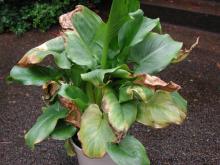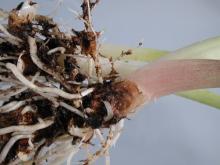See:
Iris, Rhizomatous (Iris spp.) - Bacterial Soft Rot
Cause The bacteria Pectobacterium carotovorum enters plants though wounds. Wounds may be from physical injury to the rhizomes or from living organisms like insects or fungi. Soft rot may be secondary to many other diseases such as those caused by Pythium. The disease is favored by moist conditions. Frost can also cause a meltdown of the entire plant. The bacteria survive in old plant debris and infected rhizomes. Transplanting, irrigation water or cutting and digging tools can spread the bacteria. This disease is considered the most important factor limiting production.
Symptoms Plant parts become soft and slimy. Generally found at the base of leaves or anywhere on the rhizome. Leaves may appear water-soaked and are soft and slimy. Leaves start out turning dark green, may have spots then wilt, turn yellow and die. Typically, the foliage and flower stalks develop a brown, soft rot at the soil surface. Roots may show a clear collapse that can be confused with Pythium. The bulb eventually becomes mushy with a fishy odor and slimy texture.
Cultural control
- When receiving rhizomes, unpack immediately and let dry out under mild dry conditions to let abrasions heal.
- Discard any diseased rhizomes immediately. Wash hands and equipment well before handling more plant material.
- If soaking in Gibberellic acid for increased flowering, make sure soak times are short and rhizomes dry quickly and thoroughly. Dip tanks should use fresh water and be cleaned frequently.
- Plant in well-drained soil or soilless media at a pH of 6.0 to 6.5 and with day temperatures around 78°F.
- Be sure to plant the rounded side down and the part where the roots and sprouts emerge at the top.
- Keep rooting media moist but not overly wet or dry. When irrigating, do not let water pool or splash. If an outbreak occurs stop irrigating right away and let plants dry out before removing. Drip irrigation is better than overhead irrigation.
- Do not apply excessive nitrogen.
- It has been reported that yellow- and orange-colored cultivars are susceptible while white- and cream-colored cultivars are not as susceptible.
- Control fungus gnats and shore flies.
Chemical control Focus on cultural control tactics. Fungicide drenches (a mix of two or more) are recommended to prevent injury from soilborne fungal pathogens. Several bactericides are also used in the industry but few are legal. Disinfectants may be used but have a very short, if any, residual effect.
- Agri-Mycin 50 at 2.7 to 5.3 oz/100 gal water. Tolerant strains of bacteria easily develop with repeated use of this product. Alternate with other bactericides to prevent or delay buildup of tolerant strains. Group 25 fungicide. 12-hr reentry.
- Phyton 27 at 3 oz/10 gal water. Soak bulbs for 5 min. and allow to dry before planting. May not be very effective. M1 fungicide. 48-hr reentry.
- KleenGrow at 0.15 to 1.5 fl oz/gal water. Soak for 30 seconds and allow to drain.
Reference Ngamau, K., Mugai, E.N. and Ng'ayu, B.N. 2008. Effect of irrigation and mulch on the incidence of Erwinia soft rot, flower and tuber production of Zantedeschia 'Black Magic' and 'Florex Gold'. Acta Hort. 766:193-198.




